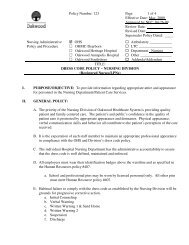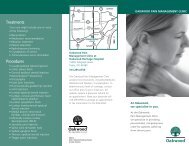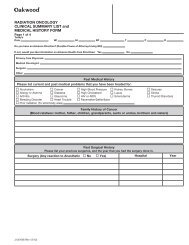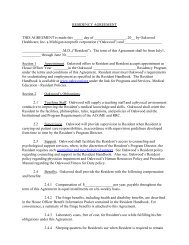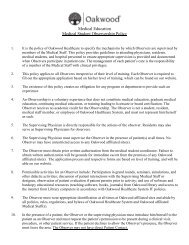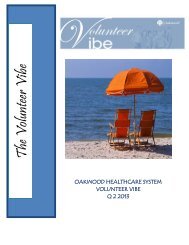Volunteer - Oakwood Annapolis Hospital
Volunteer - Oakwood Annapolis Hospital
Volunteer - Oakwood Annapolis Hospital
You also want an ePaper? Increase the reach of your titles
YUMPU automatically turns print PDFs into web optimized ePapers that Google loves.
To: All Patient Care Staff<br />
From: Department of Infection Prevention and Control<br />
Date: 08/30/2011<br />
Re: Clostridium difficile on the rise<br />
The following reminders are proven techniques to reduce the spread of C. diff. (Clostridium difficile (C. diff)<br />
infections.)<br />
Important Reminders:<br />
� It is critical that all healthcare workers follow strict hand hygiene and isolation protocols.<br />
We are all partners in patient safety – it is essential to take the time to educate patients, visitors, and even your<br />
colleagues/fellow health care providers on the importance of hand hygiene.<br />
o C. diff is spread by ingestion of bacteria and can infect healthy people. Patients and healthcare personnel are at<br />
risk of C. diff disease, so it is important to be vigilant.<br />
o Encourage patients to wash their hands or to use alcohol hand wipes before eating meals.<br />
o Anyone touching the patient, equipment, or environment can spread C. diff<br />
o If you see someone who has not washed their hands or used alcohol-based hand rub when they should have,<br />
address the situation in a professional and courteous manner.<br />
Examples include:<br />
� “Have you remembered to wash your hands?”<br />
� “I am requesting that you wash your hands for our patient‟s safety.”<br />
� Wash your hands with soap and water immediately after removing gloves when caring for a suspected or confirmed C.<br />
diff patient or touching the patient environment.<br />
o If no clean sink is available in the room, use alcohol hand rub then wash with soap and water as soon as possible.<br />
Do not touch equipment or the environment on the way to a clean sink – this causes C. diff spore contamination.<br />
o Use a clean paper towel to turn off the faucet to keep your hands clean.<br />
� Wear gloves and gown to enter the room every time.<br />
o Personal protective equipment must be worn correctly for it to work.<br />
� Gowns must be fastened in the back at the waist and neck to prevent contamination of clothing. A recent<br />
Joint Commission survey resulted in a citation for healthcare workers not wearing gowns properly.<br />
� Gloves must be pulled over the cuffs of the gown to prevent contamination of clothing and hands.<br />
� Use the yellow, disposable stethoscopes for Contact Precautions patients.<br />
o If you must use a non-disposable stethoscope it must be thoroughly disinfected with a bleach wipe upon<br />
exiting the Contact Precautions room.<br />
o The stethoscope must be rubbed with the bleach wipe to create friction and stay wet with bleach for a total of<br />
5 minutes in order to kill the C. diff spores.<br />
� Watch for C. diff symptoms in all patients<br />
o Symptoms include more than three (3) episodes of diarrhea a day, abdominal pain, fever, and foul stool odor.<br />
o Recent exposure to antibiotics is frequently a predictor of C. diff-associated diarrhea.<br />
o If you suspect a patient has C. diff, start Contact Precautions immediately.<br />
<strong>Volunteer</strong> Vibe – 3 rd Quarter Page - 12 -



